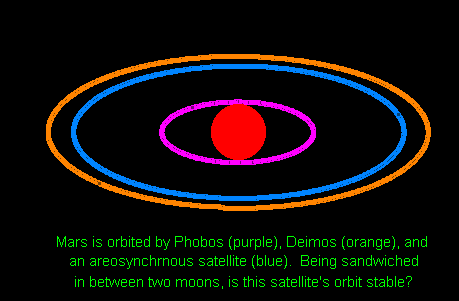Can An Areosynchronous Satellite Maintain A Stable Orbit?
Earth has many satellites orbiting it in a special place. Thirty-seven thousand kilometers above the surface of the Earth, a satellite in a circular orbit is said to be in a geosynchronous orbit. The satellite orbits the planet in exactly 23 hours and 56 minutes, the same amount of time it takes the Earth to rotate once. Therefore, the satellite always stays above the same part of the Earth. Such satellites are useful for communications and weather observation.
If humans are to ever colonize the planet Mars, areosynchronous satellites that hover over the same portion of Martian surface would also be useful for communication and observation. The areosynchronous satellites would have to orbit 20,400 km from the center of Mars.This would give them the right speed to exactly pace the planet's rotation.
There might be a problem, however. Unlike Earth, Mars has a natural satellite, Deimos, orbiting only 3,000 km above the areosynchronous region. It also has another natural satellite, Phobos, orbiting just over 10,000 km interior to the areosynchronous region. Although these moons are not very massive compared to Earth's moon, their close proximity to the areosynchronous region might make it impossible for a satellite in that region to maintain the perfect speed needed to keep pace with Mars' rotation.

To find out, I set up the simulation Areosynchronous. I set a satellite in areosynchronous orbit in the year 1995. I ran the simulation for 20 years, letting the satellite orbit between the orbits of Phobos and Deimos. In the simulation year 2015, I observed that the satellite's eccentricity, semi-major axis, and period were virtually unchanged. Apparently, although Phobos and Deimos are close, their low mass was not enough to affect the satellite in any meaningful manner. A satellite in areosychronous orbit would be much like a satellite in geosynchronous orbit around Earth. Only small corrective maneuvers would be needed to keep it in its desired orbit.
Download the simulation Areosynchronous . (You need to have the program Gravity Simulator installed on your computer first. Click Here to download Gravity Simulator.)
|

